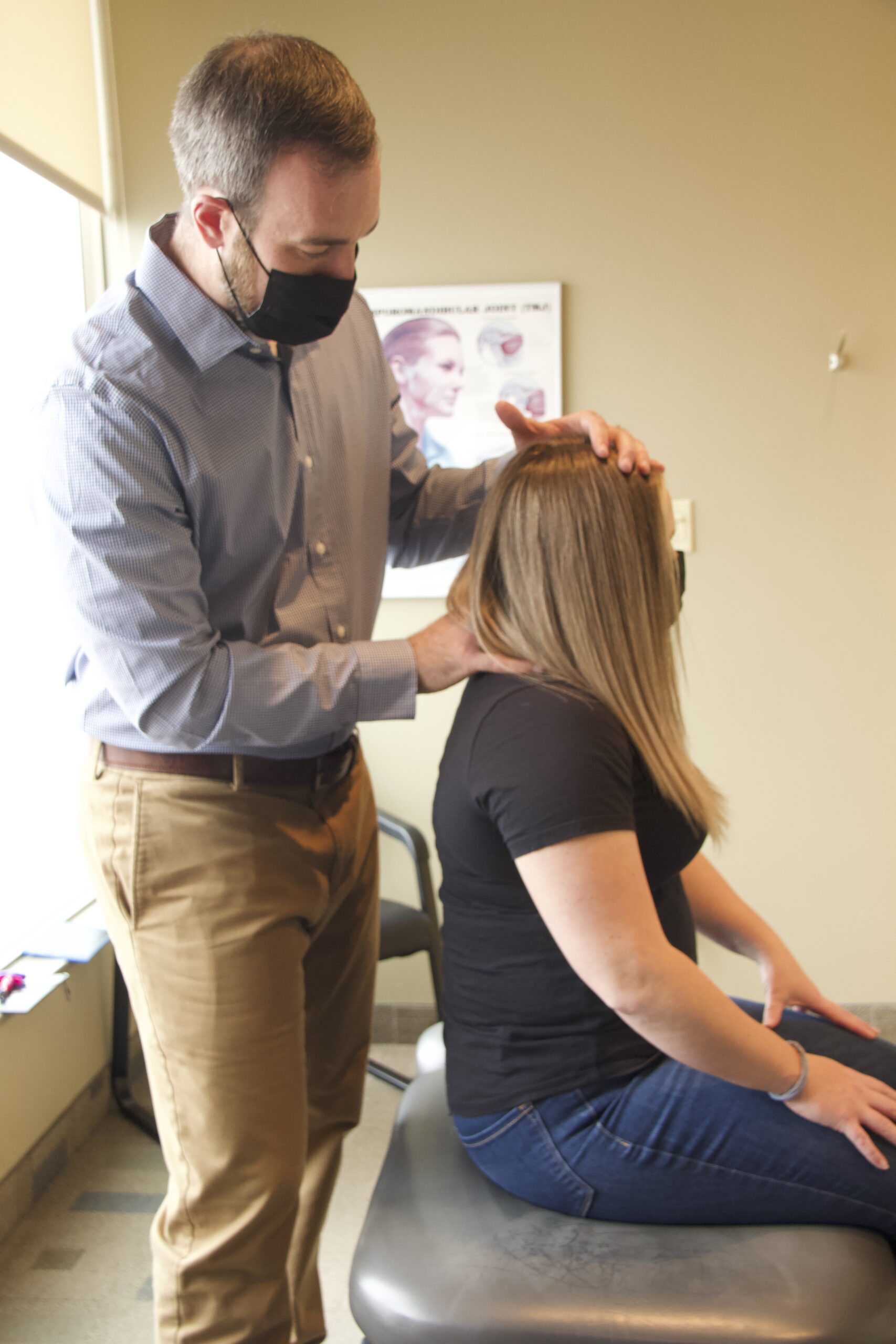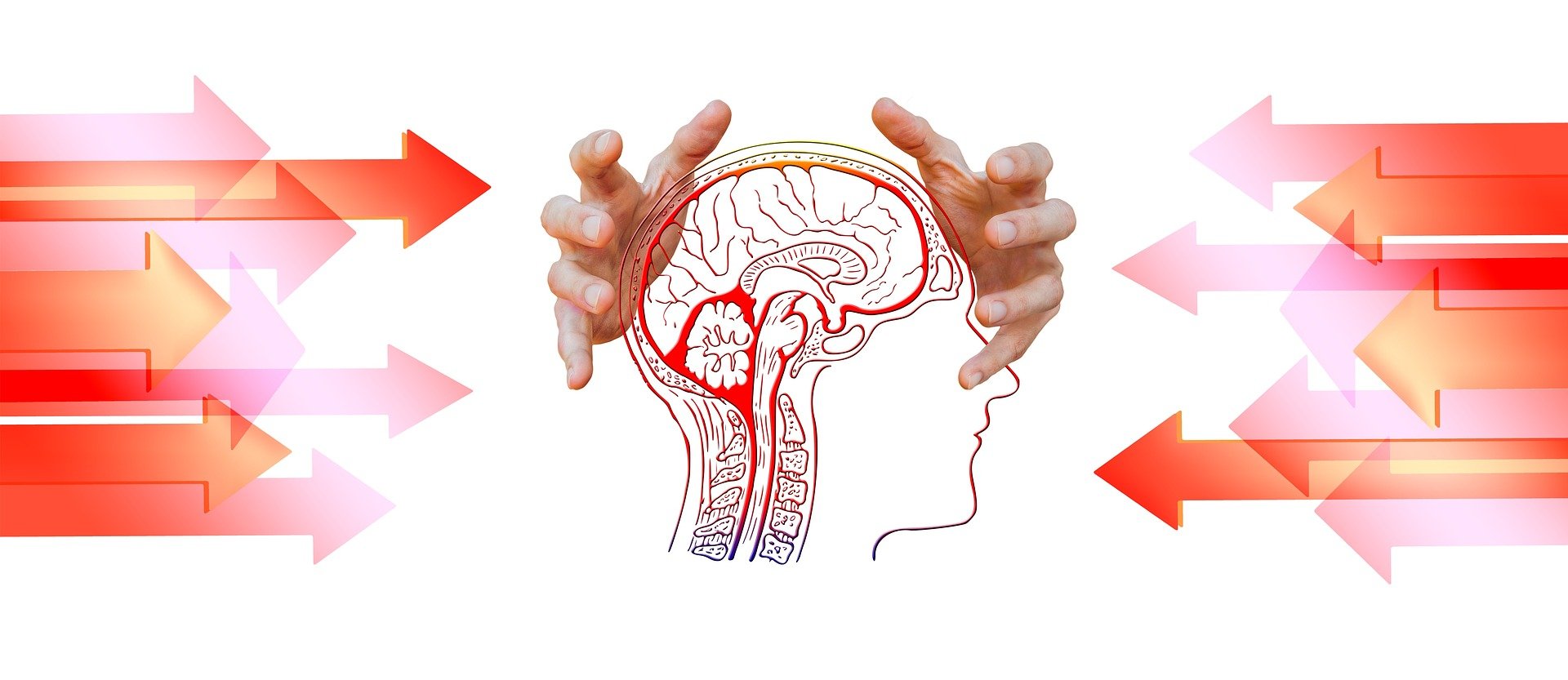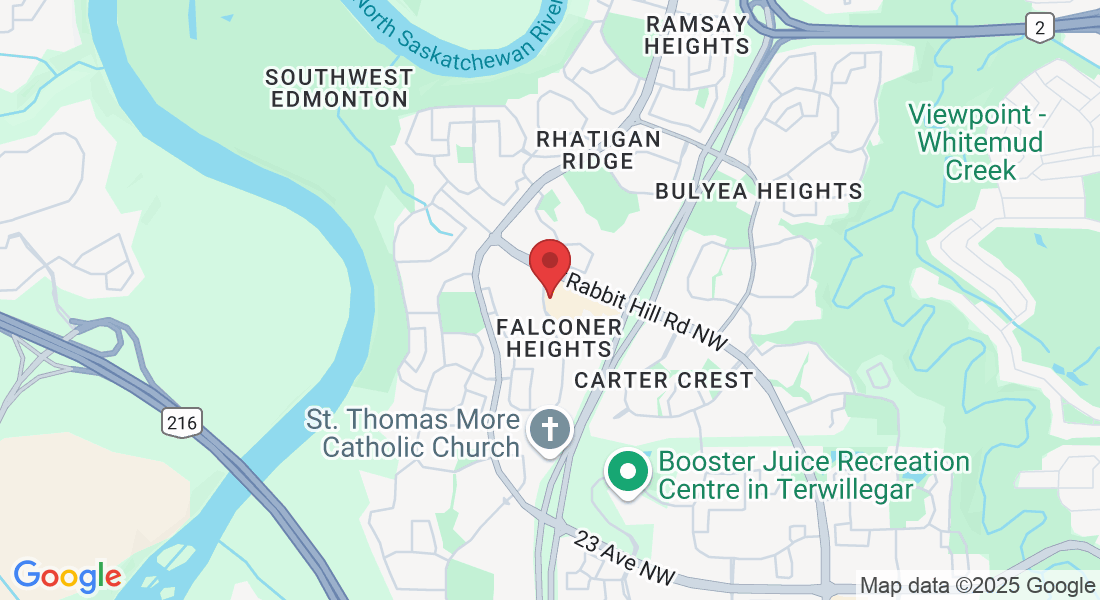Looking for pain relief, without addictive drugs? You're in the right place!
Riverbend Chiropractic & Wellness
Chiropractic orthopaedic specialist, Dr. Joseph Tanti and his team of chiropractors & massage therapists in Edmonton, AB, can help you with pain relief without addictive or dangerous drugs - so you can get back to LIVING life!
Jacqui did it, and so can you!
You can get out of pain, fast, completely rehabilitate your injuries, and get back to LIVING life! (without addictive drugs)
I understand the challenges of dealing with pain in your spine and joints while trying to maintain an active lifestyle. You can break free from pain, fully rehabilitate your body, and reclaim your ability to live life to the fullest!
As a chiropractor, and chiropractic orthopaedic specialist with years of experience treating spine and joint-related aches, pains, and injuries, you get personalized care, including a comprehensive rehabilitation program designed to address your unique needs.
Whether you're struggling with arthritis, recovering from a catastrophic injury, or seeking to improve your health, we are dedicated to helping you reach your goals.
Don't let pain hold you back any longer. Take the first step towards a healthier, happier you, and speak with a specialist today.
Hours We Are Open
Chiropractors
Monday 8:00 - 6:00
Tuesday 2:00 - 5:00
Wednesday 8:00 - 6:00
Thursday 2:00 - 7:00
Friday 8:00 - 4:00
Saturday 9:00 - 12:00
*Closed 12 - 2 for lunch
**We will come when we are closed on Saturday and Sunday if you ask nicely, and we will happily charge an absurdly large fee :)
Massage Therapy
Monday 9:30 - 2:00
Tuesday 9:30 - 2:00
Wednesday 9:30 - 2:00
Thursday 3:00 - 9:00
Friday Closed
Saturday Closed
"Its like magic! I feel so much better!"
Marina
"I couldn't hold onto anything. Now I can!"
Lillian
"I feel so great, I could jump to the ceiling!"
Anna
"The pain was permanent...but now its gone!"
Hugh
"My foot feels great, and we had the perfect holiday"
Diane
I would highly recommend Dr. Tanti. I went to see him for chronic headaches and had relief after my first appointment. He has a holistic approach and truly listens to his patients.
Meagan Jakubec
Google Review
After suffering from a chronic SI condition I visited Dr. Joe Tanti at Riverbend Chiropractic. His manner is warm and welcoming and treatments are professionally administered. I also like that he is treating my back issues in a more holistic by including therapeutic exercises which I can undertake at home. A five star review for Dr. Joe.
Sherri Rourke
Google Review
Spine
Spine conditions are one of the leading causes of pain and disability world wide. You don't have to be part of that group!
Joint
Joint pain and injuries can ruin your day, and affect your life. The good news is you don't have to suffer any longer!
Arthritis
Arthritis impacts over 2.4 million Canadians. While there is no 'cure', it can be treated, and often the pain eliminated, and function restored!
Headaches
Headaches affect 50% of people. The most common type of headaches - migraines, tension headache and cervicogenic headache - greatly benefit from chiropractic care!
So if you are suffering with headaches, and would like help stopping them, we can help!
Migraines
Migraines are more than 'just a headache'. They are a complex neurological condition, with head pain being one of the key features.
If you are dealing with migraines, we can help! I have found that if you are suffering with migraines that start with neck pain, you could have a nearly miraculous improvement with chiropractic care!
If you're migraine does not start with neck pain, chiropractic care when combined with a multi-pronged approach can be a game changer.
Neck Pain
Spine pain - including neck pain - is one of the leading causes of disability world wide. The cause of neck pain varies from person to person.
The short list of neck pain causes are arthritis, muscle, joint, nerve, and disc problems.
The good news is that you don't have to struggle with neck pain anymore!
Back Pain
Spine pain - including back pain - is one of the leading causes of disability world wide. If you have a foot problem, you can still get around and live life.
When your back hurts, it makes it nearly impossible to do anything at all. Getting out of bed, getting dressed, even just standing up can be next to impossible.
As someone who has dealt with serious back pain, I know exactly what it feels like. And I know that chiropractic care is the solution!
Disc Herniation and Bulge
Disc injuries are the leading cause of back pain, causing roughly 40% of all back pain.
These injuries can cause symptoms that range from local stiffness, to pain, to causing lighting, a hot wire, or fire to shoot down your leg!
The good news is that chiropractic care is part of the solution. It takes more than simply 'aligning' the spine.
Disc herniations and disc bulges require a comprehensive approach such as the one we use at Riverbend Chiropractic & Wellness!
Stenosis
Stenosis is a fancy word for describing a narrowing within the spine that often occurs as we age.
This condition will often cause back pain, neck pain, along with pain shooting into your arm or leg.
This narrowing causes a smaller amount of space for the nerve, along with all of the other neuro-vascular structures to travel through.
When there is dysfunction, restrictions, scar tissue formation in combination with stenosis, you will often experience the symptoms described above.
A conservative, non-surgical comprehensive approach to treating stenosis is often successful in significantly reducing the pain, and improving your function! Obviously no conservative therapies are able to cause structural changes to your spine.
However, we are able to make functional improvements, and I have often helped my patients suffering with stenosis become pain free!
Sciatica
Sciatica is a fancy word the medical community uses to describe leg pain. There are many potential causes of sciatica. These causes include a pinched or inflamed nerve, joint or muscle.
While each condition can cause sciatica, they each require different treatment strategies.
The good news is that we are experts in determining what is cause for your sciatica pain is, AND treating it!
Pelvic Girdle Pain
Pelvic girdle pain is especially common during and after pregnancy. When you are pregnant, not only are biomechanical changes happening to your body, but hormonal changes as well.
You may have noticed feeling different? Food cravings? Unexplained happiness or bursting into tears for no reason at all? Feeling "hormonal"?
These hormonal changes also affect how you feel, and how your joints and muscles work, leading to pain.
This pain can even last postpartum. The good news is that we are experts in getting you feeling better, back on track, so you can focus on whats important - taking care of your beautiful baby, without having to worry about your pelvic girdle pain.
TMJ - Jaw Pain
The temporomandibular joint (often referred to as the TMJ) causes pain and problems for many people.
Whether from stress (clenching and grinding), or trauma (a fall, head butt or punch to the face), the TMJ can become injured.
Pain, popping, and locking are all common side effects. If you are dealing with TMJ problems, we can help!
Shoulder & Rotator Cuff
The shoulder is one of the most commonly injured joints in the body.
I've injured my left shoulder myself. So I know all about shoulder injuries, the pain, and the rehabilitation that is required!While the rotator cuff is most commonly injured - either a strain, tendinopathy, or tear- other issues can also cause shoulder pain.
Bursitis, impingement, labrum, bankart injuries and dislocations (like the one I had - OUCH!), just to name a few.
Bottom line: if you are dealing with a shoulder problem, we can help!
Tennis Elbow
Tennis elbow (and golfers elbow) does not only affect tennis players and golfers!
Elbow pain can range from a slight annoyance to making it impossible to grab anything. Even turning a door handle can be painful!
Many methods fail to appropriately treat elbow pain because they simply stop at pain reduction. To make lasting change, you need pain reduction strategies, an appropriate tissue loading and strengthening approach, along with a thought out approach to managing the bio-mechanical stressors affecting your elbow.
Bottom line: we can help get rid of your elbow pain, even if others could not!
Hand & Wrist Pain
Hand and wrist pain can come in many shapes and sizes. For some people it is a mild inconvenience.
For others, they are completely handicapped. Not being able to use their hand for anything due to the pain.
At Riverbend Chiropractic & Wellness, we can help solve your hand and wrist pain. From sprain/strains, to tendonitis, pulley ruptures, and more.
Carpal Tunnel Syndrome
Carpal tunnel syndrome is one of the most common peripheral nerve injuries. It is caused by compression of the median nerve inside of the carpal tunnel - your wrist.
Let me ask you: does your hand go numb at night? While working, typing, or grabbing things? Are you dropping stuff? Do your hands feel clumsy? Are your hands numb, burning, or tingling?
If yes, you may have carpal tunnel syndrome. I have found that mild to moderate cases of carpal tunnel syndrome can be effectively treated without surgery or shots. Severe cases can also be treated, however, it is much more challenging, and takes much longer.
Often patients re not willing to do what needs to be done, and surgery is required.
This is why it is so important to treat carpal tunnel syndrome BEFORE it becomes severe. Fortunately, at Riverbend Chiropractic & Wellness we can help!
Hip Pain
Hip pain does not just affect seniors. I've successfully treated children, young adults, and not - so - young adults successfully for their hip pain.
There are many possible causes of hip pain. These include problems with the joints, muscles, tendon's, bursae, and nerves.
Many people with hip pain think it is due to arthritis. While this does occur, it is not as common as people believe, especially under 50.
At Riverbend Chiropractic & Wellness, we assess, diagnose and successfully treat all causes of hip pain on a daily basis.
If you are struggling with hip pain, you owe it to yourself to get it under control. We can help get you there!
Ankle Pain
Ankle pain and injuries can severely affect your mobility, and ability to function in every day life.
If severe enough, you can't even put any weight on it. While most ankle injuries get better on their own, some require extensive therapy.
You certainly don't want to end up having a chronic ankle sprain! Where nearly every other day your ankle gives out from just stepping off the curb.
The good news is at Riverbend Chiropractic & Wellness, we can help you with even the most severe of ankle sprains. Even the chronic ankle sprain that your just sick and tired of dealing with.
Plantar Fasciitis & Foot Pain
If you have been experiencing heel pain those first few steps in the morning, you may have plantar fasciitis.
Sometimes it feels like you are stepping on a marble, or even a nail. If it gets worse, the pain starts to travel into the arch of your foot, and starts to affect you throughout the day. No longer just those first few steps.
Some people with plantar fasciitis walk like they are walking on broken glass!
Fortunately at Riverbend Chiropractic & Wellness we have all the tools needed to get you back on your feet - pain free!
Neck Arthritis
Constant discomfort and pain that accompanies neck arthritis shouldn't hinder your daily joys and independence.
You have likely been told, or may think that there is 'nothing you can do about it". Wrong.
You can get better. You can have better mobility, flexibility, less pain - possibly even no pain!Say goodbye to frustration and fear, and hello to a life of improved mobility and vitality - and feel 10 years younger.
At Riverbend Chiropractic & Wellness we can help you on your journey towards long-term relief and freedom.
Back Arthritis
Constant discomfort and pain from back arthritis shouldn't hinder your daily joys and independence. Stop letting your back pain decide what your plans are for your day.
You have likely been told, or may think that there is 'nothing you can do about it".
Wrong.
It can get better! Better mobility, flexibility, less pain - possibly even no pain!
Say goodbye to the frustration and fear, and hello to a life of improved mobility and vitality - and to feeling 10 years younger.
At Riverbend Chiropractic & Wellness we can help you on your journey towards long-term relief!
Hip Arthritis
Hip arthritis can be brutal. The slow onset of stiffness, achiness...then one day the pain starts.
You have likely been told, or may think that there is 'nothing you can do about it". You may have been told that you aren't bad enough for surgery, and to just suck it up.
Maybe you've been told you need surgery...but now what do you do during the 18month wait list?
Told there is nothing else you can do?Wrong.
It can get better! Better mobility, flexibility, less pain - possibly even no pain!At Riverbend Chiropractic & Wellness we can help you with your hip arthritis, and help you on your journey towards long-term relief!
Knee Arthritis
Knee arthritis can be brutal. The slow onset of stiffness, achiness...then one day the pain starts.Limping, dragging your leg...have to take stairs? Forget about it.
You have likely been told, or may think that there is 'nothing you can do about it". You may have been told that you aren't bad enough for surgery, and to just suck it up.
Maybe you've been told you need surgery...but now what do you do during the 18 month wait list? Told there is nothing else you can do?
Wrong.
It can get better! Better mobility, flexibility, less pain - possibly even no pain!Many of my patients are now running up stairs!
At Riverbend Chiropractic & Wellness we can help you with your knee arthritis, and help you on your journey towards long-term relief!
Ankle Arthritis
Ankle arthritis is very rare, unless you've had a bad ankle injury in your past.
It can be constant, and completely stop you from being able to walk.
You have likely been told, or may think that there is 'nothing you can do about it". You may have been told that you aren't bad enough for surgery, and to just suck it up.
Maybe you've been told you need surgery...but now what do you do during the 18 month wait list? Told there is nothing else you can do?
Wrong.
At Riverbend Chiropractic & Wellness we can help you with your ankle arthritis, and help you on your journey towards long-term relief!
Shoulder Arthritis
Shoulder arthritis is common. Especially if you've had a history of a shoulder injury, fracture, or chronic rotator cuff problems.
The pain can be constant, and stop you from being able to use your arm!
You have likely been told, or may think that there is 'nothing you can do about it". You may have been told that you aren't bad enough for surgery, and to just suck it up.
Maybe you've been told you need surgery...but now what do you do during the 18 month wait list?
Told there is nothing else you can do? Wrong.
At Riverbend Chiropractic & Wellness we can help you with your shoulder arthritis, and help you on your journey towards long-term relief, and be able to use your arm again!
Wrist & Hand Arthritis
Wrist and hand arthritis is very common, affecting millions of Canadians.
It impacts your day, and quality of life.Opening jars, doors, buttoning buttons, brushing your hair...nearly everything you do that uses your hands becomes a struggle, if not impossible.
You have likely been told, or may think that there is 'nothing you can do about it". You may have been told that there is nothing that you can do.
Wrong.
At Riverbend Chiropractic & Wellness we can help you with your wrist and hand arthritis, and help you on your journey towards long-term relief!
"Here to make you feel pawsome!"
"Hey there, friend! When you walk through our doors, you're not just another patient—you’re part of our pack! I have a warm, welcoming space where the humans really know how to take care of you. Whether you’re aching or just need a little boost, you’ll find comfort here, and maybe even my wagging tail to greet you!"
One of Edmonton's 3 chiropractic orthopaedic specialists
Direct billing
PhD in Tail Wags, with a speciality in making you smile
Open evenings, and Saturday
Murphy - Puppy Overlord and Clinic Mascot

Meet the Chiropractors, Massage therapists and Team at
Riverbend Chiropractic & Wellness
Dr. Todd Berg

Dr. Joseph Tanti

Kim

Julia

Murphy

Frequently Asked Questions
Do you take insurance?
Yes! We direct bill most insurance companies. While there are a few plans that do not allow us to direct bill, most do.
Here is a list of all of the insurance companies we accept:
Alberta Blue Cross
Benefit Plan Administrators - BPA
Blue Cross
Canada Life
Canada Construction Workers Union
Chambers of Commerce Group Insurance
CINUP
Claim Secure
CowanD.A. Townley
Desjardins Insurance
First Canadian
GMS Carrier 49, 50
Great West Life
Green Shield
Group Health
Group Source
Industrial Alliance
Johnson Inc.
Johnston Group Inc.
La Capital and Financial Services
LiUNA Local 83, 506
Manion
Manulife
Maximum Benefit
People Corporation
R.C.M.P. (Blue Cross)
RWAM Insurance Administrators
Sun Life Financial
TELUS AdjudiCare
Union Benefits
V.A.C. (Blue Cross)
WCB
Motor Vehicle Collisions
What problems can chiropractic and massage therapy treat?
At Riverbend Chiropractic & Wellness, our chiropractors and massage therapists commonly treat problems with the spine, joints, and arthritis.
This includes neck pain, headaches, back pain, disc injuries, shoulder injuries and more.I often tell people, if you are hurt or injured somewhere between your head and your toes, we can probably help!
If you have an organ problem (i.e. a heart attack, stomach ulcer, etc) go to the hospital!
Is treatment safe?
Because chiropractic is non-invasive, the risk of a serious side effect is extremely low. While most people feel a sense of relief, it is possible that following chiropractic manipulations you may experience mild soreness that should go away quickly.
Before you have a chiropractic treatment, ask to discuss any concerns you have with us. If you have any severe or lasting effects or concerns over when to stop chiropractic treatment, talk to us and let us know.
We always work with you, do what is safe and at your comfort level.
Is there any evidence for chiropractic? I heard it is a bunch of mumbo-jumbo...
Chiropractic care is evidence-based. National and international researchers, both within and outside the chiropractic profession, are actively involved in studying the safety and effectiveness of chiropractic for patient care.
In fact, there is a chiropractic PhD in universities in every province across Canada! The Alberta Chiropractic association supports ongoing Alberta research as well as national research from the Canadian Chiropractic Guideline initiative.
This growing body of evidence continues to prove the value of chiropractic care with consistently high marks for clinical effectiveness, cost efficiency and patient satisfaction.
If you would like to explore research, please visit the World Federation of Chiropractic’s suggested reading list and the Canadian Chiropractic Guideline Initiative’s website.
When should I see a chiropractor or massage therapist?
There are many reasons people see a chiropractor and massage therapist. Stress relief, sports performance, however most people start seeing a chiropractor or massage therapist because of pain or injury.
If you are struggling with sporadic or chronic pain, a chiropractor and massage therapist may be able to help. You do not require a referral to visit a chiropractor or massage therapist. There are a few insurance plans that require a referral for massage therapy to be covered by insurance, but not many. Check your plan for details, or give us a call.
Some people see a chiropractor and massage therapist to avoid having pain in the first place. Like visiting your dentist, and getting your teeth cleaned for 'maintenance', some people find this approach helpful.
Recent Posts

Cervicogenic Headaches
Cervicogenic headache are a common type of headache, especially after an motor vehicle accident, injury or blow to the head or neck.
Cervicogenic headache are often misdiagnosed due to their symptom overlap with other headache types, such as tension headache or even migraine. It is a unique condition - a secondary type of headache - where the problem originates from the neck and pain radiates to the head or face. Understanding its characteristics is crucial for proper diagnosis and treatment so you actually get better.
These headaches can make it nearly impossible to focus, and difficult to move your head because the neck pain.
In this article we explore the symptoms, causes, diagnosis, treatment, and prevention strategies of cervicogenic headaches.
You may feel like there is nothing you can do about it right now, but rests assured, within just a few minutes after reading this, you will be well on your way to a headache free future!
Key Takeaways
Cervicogenic headaches are characterized by pain that starts in the neck, typically the base of the skull and may extend to the forehead, temple, or eyes, often accompanied by neck stiffness and limited motion.
These headaches are commonly one-sided, can last from hours to a week, and may be triggered or alleviated by neck movements, postures, or pressure.
Diagnosis involves a thorough medical history, symptom assessment, and physical examination, with diagnostic tests to differentiate from other headache types.
Treatment options range from conservative management strategies such as chiropractic care, and physiotherapy.
Prevention and management include lifestyle modifications, ergonomic adjustments, regular exercise, stress management, and understanding and avoiding known triggers.

Understanding Cervicogenic Headache Symptoms
Pain Patterns and Intensity of Cervicogenic Headaches
Imagine your head is like a drum, and inside, a steady beat of pain throbs from the back of your skull to your eyes. Sometimes a better analogy is your head as a pin cushion, with a stabbing pin behind your eye, on the side, or even back of your head. This is what a cervicogenic headache can feel like.
The unique feature with cervicogenic headaches is that the pain often starts at the neck and then travel into your head, up behind your eyes, to your temple, or back of your head. The intensity can range from a dull annoying ache to a sharp, stabbing, debilitating sensation.
Cervicogenic headaches are the unwanted guests that can show up at any time and stay for hours, days, even years. That relative that stops by and just never leaves. They can make it hard to focus, and can make you miserable. Here's what you might notice:
A pain that feels like it's starting in your neck, and travels into your head from the neck
The pain is on one side and doesn’t shift from side to side.
Your neck is stiff, has reduced range of motion and the more painful your neck becomes, the worse your headache gets.
While symptoms may be similar to other forms of headaches such as tension headaches or migraines they are not the same! Migraines and tension headaches are primary type headaches, while cervicogenic headaches are a secondary headache.
Primary headaches mean that they are a condition in themselves and have triggers that elicit the headache. Secondary headaches are due to another condition. In the case of cervicogenic headaches, the injury or problem with your neck actually causes the headache!
While both can make your head hurt, cervicogenic headaches start because of problems in your neck, not just stress or muscle tightness.
Neck Pain and Stiffness Are Common In Cervicogenic Headaches
Imagine your neck is like a garden hose. When it's kinked, water can't flow well. Similarly, when your neck is kinked, it can give you a headache. This kind of headache starts because of problems in your neck. Your neck might feel tight, and like something is stopping it from moving normally.
Neck pain can be sharp or dull
It typically causes a reduced range of moment, making turning your head difficult
Sometimes pain radiates not just into your head, but also into your upper back, shoulders and arms.
While a stiff neck doesn't always mean a headache is coming, it is a common sign.
Limited Range of Motion and Trigger Points
When your neck is working right, it behaves like a neck should! You can turn it easily, and life Is good. But with a cervicogenic headache, turning your neck feels like trying to swivel a rusty chair. It just doesn't want to move! This is called having a limited range of motion.
Your neck might also have 'trigger points'. These are areas of muscle that bundle up tight and spasm. They can be a huge factor in your headache!
When pressed, trigger points often cause the pain to shoot up into your head, even into your shoulder or arm. It's like stepping on a squeaky toy that surprises you with a loud noise. Only, it's not a noise; it's a headache.
Pain in the shoulders or upper back
Limited range of motion in the neck
Headaches triggered by neck movements
Headaches that worsen with certain positions
Remember, these signs are your body's way of telling you something's not right. Listen to your body.
Ruling out Bad Stuff With Headaches
With any headache, the firsts thing we want to do is to rule out ‘bad stuff’. We want to pay attention to red flags. These include:
Severe and Unfamiliar HA,
Fever,
Significant neck Stiffness,
Rash,
Nuchal Rigidity,
Facial Numbness,
Vertigo,
Diplopia,
Difficulty Walking,
Nausea,
Nystagmus.
Once we have ruled out possible ‘bad things’, we can start narrowing down on the actual diagnosis.
Interestingly, diagnostic imaging is rarely helpful in determining the type and cause of headache. Typically diagnostic imaging such as X-ray, or MRI are helpful to rule out other diagnoses, especially when one or more of thees ‘red flags’ are present.
However, diagnostic imaging is typically the same in those with cervicogenic headache, and those without one.

Cervical Spine Issues and Their Impact on Cervicogenic Headaches
Cervicogenic headaches on average affect women in their 40’s. Sorry ladies, s but cervicogenic headaches are four times more common in women than men.
They are especially common in someone who has experienced trauma, such as a motor vehicle collision, concussion, or incident from a sporting event, or fall. Weight lifters also commonly experience cervicogenic headaches.
I’ve had patients who were boxers present with cervicogenic headache. They all deny trauma…despite their job literally exposing them to trauma daily.
How Cervicogenic Headaches Look and Feel
The pain intensity of cervicogenic headache scan vary. They can be as debilitating as a bad tension headache, or even a migraine. Hence why a ‘bad headache’ isn’t always a migraine.
They are typically on one side of your head, and that side doesn’t change. However some people do experience them soon both sides. Often times theses with cervicogenic headache will exhibit kinesiophobia - a fear of movement.
The reason for this is that there is a neck problem. And moving their neck will often intensify their headache. Anxiety is also common for those with cervicogenic headaches, especially if after a motor vehicle accident, and whiplash injury. Think of your neck like a stack of blocks. When the blocks start to wear out or get damaged, it can cause a lot of trouble. This is what happens with cervicogenic headaches. The bones and cushions in your neck, called discs, can wear down over time. This is called degeneration. It's like when a door hinge gets rusty and creaky. Your neck can feel the same way, and that pain can move up to your head.
Here's a quick list of things that can cause cervicogenic headaches:
Arthritis in your neck
Disc problems in your neck
Neck injuries, like whiplash, or concussion
Bad posture for long periods of time
Remember, cervicogenic headaches are because of a problem with your neck. If you solve the neck problem, the headaches go away! This is where seeing a specialist comes in handy.
Trigger Factors and Lifestyle Considerations
Think of your body like a car. Just like a car needs the right fuel, tires, and maintenance, your body needs good habits to keep running smoothly. Bad habits can be like sugar in your gas tank - they mess things up! Coincidently extra sugar in your body can mess you up too…it just takes longer to take effect than in a gas tank…but I digress…
Here are some things that can trigger cervicogenic headaches:
Inactivity, like when you sit on the couch all day.
Bad posture, like slouching at your desk all day at work or gaming all night.
Stress, causing your shoulders to be by your ears.
Poor sleeping hygiene, like staying up too late.
To keep cervicogenic headaches away, think about what you do every day. Are you sitting like a bump on a log? Are you glued to your screen? Try to move more and sit up straight. Do your exercises. See the proper healthcare provider. Doing these things are like giving your car a tune-up - it helps everything run better!
Differentiating Cervicogenic from Other Headache Types
There are three categories of headaches. Primary headaches, secondary and tertiary.
Primary headaches include migraine, tension headaches, cluster headaches. They are a condition all in of them selves.
Cervicogenic headaches fall into the category of secondary headache. Secondary headaches are caused by another problem or condition. A hangover is another type of secondary headache. They are because you had a bit too much fun!
Cervicogenic headaches are due to an injury of your neck. The cervicogenic headaches is coming directly from cervical spine issues.
The Anatomy and Neurology of Cervicogenic Headaches
There are over 100 different forms of headaches that are all classified into either primary, secondary or tertiary. These headaches affect nearly half of the population!.Depending on what study you read, cervicogenic headaches account for between 3-25% of all headaches
Like mosts thing sin life, the exact mechanism of cervicogenic headache is debatable. However, there is thought to be both an anatomical and a neurological explanation.
Anatomical Explanation of Cervicogenic Headaches
The anatomical basis of cervicogenic headaches are thought to be from the convergence of sensory neurons from the head, neck, and face into the trigeminocervical nucleus. The trigeminocervical nucleus (TCN) is an area within the brain steam where all of thees nerves meet. This convergence of nerves, and thus signals from all theses regions, allows bidirectional referral of pain between the neck and head.
Anatomical Explanation of Cervicogenic Headaches
A less complicated, and more anatomical or mechanical model is that mechanical irritation of the greater occipital nerve as it emerges from the suboccipital region.
Here's a simple way to tell them apart:
Tension headaches are often triggered from stress or bad posture. They can feel like your head is being squeezed.
Migraines feel like pounding or pulsing in your head. They can make you feel sick, and make you hide under the blankets crying yourself to sleep.
Cluster headaches come in waves. You can be fine for months, then you get ‘clusters’ of headaches close together. They hit one side of your head, making your eyes red, tear up, and are excruciatingly painful. They affect men more often than women and cause many people to unfortunately attempt suicide.
Remember, cervicogenic headaches are the ones that start with neck pain and then move to your head. If your neck doesn't hurt, it's probably not a cervicogenic headache.

Diagnosing Cervicogenic Headaches
Medical History and Symptom Assessment
Think of your doctor as a detective. They're like Sherlock Holmes for your head! To solve the mystery of your headaches, they start by asking about your health history. They want to know all about your past illnesses and any medicines you take.
Good doctors listen to you! They ask where it hurts, how often, and how bad. It's like they're putting together pieces of a puzzle. They might ask about other stuff too, like if you get dizzy or have trouble seeing.
Health history
Headache patterns
Other symptoms
Your doctor's goal is to make a map of your symptoms. This helps them figure out if you have a cervicogenic headache or something else.
Remember, there are over 100 types of headaches. It's important to diagnose the right one. Just like you wouldn't use a map of New York to find your way in Los Angeles, you need the right map for your headache.
Physical Examination and Diagnostic Tests for Cervicogenic Headaches
After taking your history, the doctor should perform an examination. They will check how well your neck moves, perform orthopaedic, neurological, and a cranial nerve examination. These tests allow them to determine if you have a cervicogenic headache. They should be use their hands to feel for any tender spots or knots in your muscles that might be like little alarm bells ringing for pain.
To get a clearer picture, your doctor might send you for special tests. While these tests certainly don’t rule in a cervicogenic headache, when necessary they can help rule out other possible causes of the headache.Here's some tests that they might send you for:
Blood tests
MRI or CT scans
X-Rays
Treatment Options for Cervicogenic Headaches

Conservative Management Strategies for Cervicogenic Headaches
Imagine your head is like a garden. Sometimes, it gets a headache-weed. You can pull it out. You don’t need to blow up the garden. That's like using conservative management for your headache. You don't always need strong medicine or surgery.
Using ice packs or heat can help relax your neck muscles, which can help ease off the headache. It's like giving your plants a little sun or shade when they need it.
Over-the-counter medication can be helpful, but make sure you speak with your medical doctor or pharmacist before using. These are meant for short term use. If you are using them longer than a week, they aren’t solving your problem and you need additional help.
Exercise is a key component in solving these headaches. Just like water is to helping your garden grow.
Remember, these steps are like first aid for your headache. They can help, but sometimes, you need a gardener's advice.
If your headache keeps coming back, think about visiting a chiropractic orthopaedic specialist, or physiotherapist that deals with these conditions.
These healthcare providers know about different headache-weeds and can help you find the right tools to get rid of them for good.
Dr. Joseph Tanti’s Chiropractic Orthopaedic Specialist Approach to Cervicogenic Headaches
After completing your history and examination, Dr. Tanti will know exactly what problems are causing your cervicogenic headache.
Now that we know the problem, we develop a Personalized Health Program specifically for your needs.
I will likely prescribe specific exercises and stretches, as well as other activity modifications and self care strategies you can implement right away. These are crucial. Why?
You are on your own most of the time. Even if you cane into the office for treatment EVERY DAY (which is clearly not going to happen), you would still be on your own 99% of the day.
So what you do on your own makes a huge impact on how well you improve.
I may also provide different therapies, such as myofascial release, joint mobilization and manipulation, low level laser therapy, and monitored strengthening exercises.
The key with cervicogenic headaches is to improve neck function. This involves evaluating and improving posture, biomechanics, strength and mobility, as well as addressing any other factors. This could include whiplash, or concussion - cervicogenic headaches are very common in theses scenario’s
I also work with your other health care providers when necessary. This may include your family doctor, physiotherapist, massage therapist, etc.
Some of the benefits of how I treat these conditions are that treatment is:
Non-Invasive: No surgery needed.
Drug-Free: No medicine, no side effects.
Personalized specifically to you
Holistic Approach: Fixes more than just the headache.
Often with cervicogenic headache the initial, intense pain dissipates rapidly. However, if specific exercises are not provided, and done, it typically is a reoccurring condition.
When More Invasive Procedures Are Needed
Sometimes, your headache won't go away with conservative therapies. And when these problems become stubborn, despite your best efforts, we need to take things to the next level.
This is when your medical doctor or I may refer you for additional treatment:
Nerve blocks: Like turning off a light switch, they stop the pain signals. They inject a chemical into the region that your headache is stemming from. If they block the pain coming from those nerves, they can no longer cause the pain!
Injections: These injections can be used to either reduce inflammation in the joints, or to relax the muscle spasms. If these are the structures causing the pain, the pain will stop!
Radiofrequency ablation: If the nerves have been determined to be the source of pain, we can burn the nerve, so it no longer senses pain! Of course nerves do eventually grow back, and it can have other side effects. But this might be an option.
Remember, these therapies are for when conservative treatments don't work. They're stronger - like using a grenade when a pellet gun would do - and you need a referral for these procedures.
Preventing Recurrence and Managing Chronic Cervicogenic Headaches

Lifestyle Modifications and Ergonomic Adjustments
Imagine your body is like a machine. If the parts aren't lined up right, it can start to increases your cervicogenic headaches. Your neck and head need to be functioning properly to stop the pain.
Make your workspace a pain-free zone. Adjust your chair, desk, and computer so they fit you correctly.
Think about how you sit and stand. Stand tall like a tree and sit like you're the king or queen of your desk kingdom.
Improve your sleep hygiene. Like charging a battery, good sleep helps your body heal.
Small changes in how you live can make a big difference in keeping headaches away.
Remember, a chiropractor can show you how to keep better posture. It's like having a coach for your body to keep it strong and pain-free.
Regular Exercise and Stress Management
Regular exercise is key for managing headaches, and really every other medical problem you could have. Exercises keeps your body healthy and your joints and muscles moving well.
Stress management is soften important as well. Here are some tips:
Get moving for at least 30 minutes a day. Think of it as your daily tune-up.
Take short breaks to breathe and reset.
Sleep is your body's time to repair. If you don’t sleep, you may not get better!
Keeping stress in check helps makes recovery smoother.
Remember, managing stress and staying active are key to preventing those pesky cervicogenic headaches from coming back. You need to fix your neck problem for good, so it doesn’t keep coming bak!
This might seem like a small thing, but it makes a big difference in the long run.
What to do now?
Research and experience has shown that therapies like the ones we provide, along with the correct exercises have the best outcomes for those with cervicogenic headaches. A personalized approach and program to solve your neck issues can be your solution to cervicogenic headaches.
Cervicogenic headaches - especially when chronic - can be a debilitating condition, but with the right management and preventative strategies, you can regain control of your life.
As a chiropractic orthopaedic specialist, Dr. Tanti uses a variety of treatments that have helped countless patients find relief. Don't let pain dictate your day—visit our website to schedule an appointment online and explore our success stories. Take the first step towards a pain-free life today!
Frequently Asked Questions
How can I differentiate a cervicogenic headache from other types of headaches?
Cervicogenic headaches are often one-sided, triggered or alleviated by neck movements or postures, and accompanied by neck stiffness and pain. They are caused by cervical spine issues. This is unlike migraines or tension headaches, which have different triggers - sometimes a trigger is the cervical spine.
What are the primary symptoms of a cervicogenic headache?
The primary symptoms include pain that starts at the base of the skull and radiates towards the front of the head, neck pain, limited neck range of motion, tenderness in the neck and shoulder muscles, and sometimes dizziness or nausea.
When should I seek immediate medical attention for a headache?
Immediate medical attention is needed if the headache suddenly becomes severe, and unfamiliar headache, fever, significant neck stiffness, rash, nuchal rigidity, facial numbness, vertigo, double vision, difficulty walking, nausea, nystagmus.
What causes cervicogenic headaches?
These headaches are typically caused by abnormal positions or conditions affecting the upper cervical spine bones. Common triggers include certain neck movements, poor posture, and injury or trauma to the neck such as whiplash, concussion, etc.
What are some conservative management strategies for cervicogenic headaches?
Conservative strategies include applying ice or heat, stress management, ergonomic adjustments, and avoiding known triggers. Chiropractic approaches are often very helpful.
Can cervicogenic headaches become chronic?
Yes, cervicogenic headaches can become chronic if the underlying causes are not resolved. It is important to manage triggers, maintain good posture, and engage in regular exercise to prevent recurrence
© 2024 Riverbend Chiropractic & Wellness - All Rights Reserved


